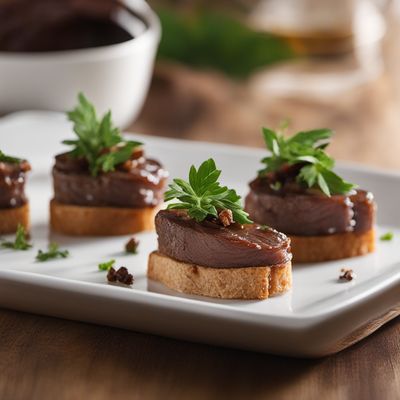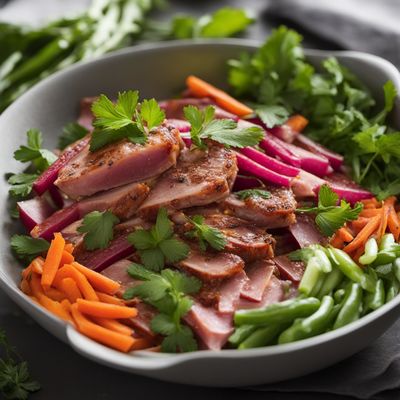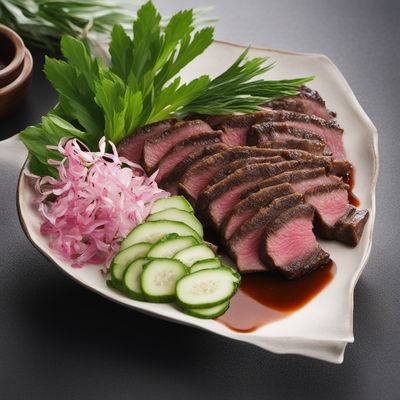
Ingredient
Cooked bovine tongue
The Savory Delicacy: Exploring the World of Cooked Bovine Tongue
Cooked bovine tongue, also known as beef tongue, is a meaty cut derived from the tongue of a cow. It is characterized by its tender, melt-in-your-mouth texture and a rich, beefy flavor. The cooked tongue has a smooth surface with a thin, papery skin that is usually removed before consumption. The meat itself is dense and succulent, with a slightly fibrous texture. Its appearance is pale pink to reddish-brown, depending on the cooking method and seasoning used.
Origins and history
The consumption of cooked bovine tongue dates back centuries and is prevalent in many cultures worldwide. It has been a staple in traditional dishes of countries like Mexico, Germany, and Japan. In Mexican cuisine, beef tongue is commonly used in tacos de lengua, while in Germany, it is a key ingredient in dishes like Zungenragout. The historical significance of cooked bovine tongue lies in its utilization as a way to make the most of the entire animal and reduce waste.
Nutritional information
Cooked bovine tongue is a nutrient-dense ingredient, rich in protein, iron, zinc, and vitamin B12. It is relatively low in fat and calories, making it a healthy choice for meat lovers.
Allergens
Cooked bovine tongue may pose allergenic risks to individuals with beef or meat allergies.
How to select
When selecting cooked bovine tongue, look for cuts that are firm and moist, without any signs of discoloration or unpleasant odor. The tongue should have a smooth surface and be free from any blemishes or bruises. If purchasing from a butcher, ensure that it is sourced from a reputable supplier.
Storage recommendations
To maintain the freshness and quality of cooked bovine tongue, store it in an airtight container or wrap it tightly in plastic wrap. It can be refrigerated for up to 3-4 days or frozen for longer-term storage.
How to produce
Producing cooked bovine tongue requires professional expertise and specialized equipment. It is recommended to purchase pre-cooked tongue from a trusted source rather than attempting to cook it at home.
Preparation tips
Before using cooked bovine tongue, it is essential to remove the outer skin by gently peeling it off. The tongue can be sliced or shredded and used in various dishes such as sandwiches, tacos, stews, or salads. To enhance its flavor, marinating the cooked tongue in a mixture of herbs, spices, and citrus juices is recommended. It can be grilled, braised, or sautéed to further develop its taste and texture.
Culinary uses
Cooked bovine tongue is a versatile ingredient used in a variety of culinary applications. It is commonly sliced and served cold in sandwiches or salads, or used as a filling for tacos, burritos, or enchiladas. The tender meat can also be incorporated into stews, soups, or stir-fries, adding depth and richness to the dish.
Availability
Cooked bovine tongue is commonly available in regions where beef consumption is prevalent, such as North America, Europe, and parts of Asia.
More ingredients from this category
Recipes using Cooked bovine tongue

Peruvian Spiced Beef Tongue Stew
Savory Delight: Peruvian Spiced Beef Tongue Stew

Limbă cu Măsline (Romanian Olive Tongue)
Mediterranean Delight: Savory Romanian Olive Tongue

Ají de Lengua with a South American Twist
Spicy Tongue Stew: A South American Delight

Canadian Maple-Glazed Beef Tongue Canapés
Maple-Glazed Delights: Canadian Beef Tongue Canapés

Guatemalan Fiambre Recipe
"Flavors of Guatemala: A Festive Fiambre Feast"

North Dakota-style Grilled Beef Tongue
Savory Grilled Beef Tongue Delight

Grilled Beef Tongue with Okinawan Twist
Savory Okinawan Beef Tongue Delight

Grilled Beef Tongue with Japanese Flair
Savory Delight: Grilled Gyutan with a Japanese Twist